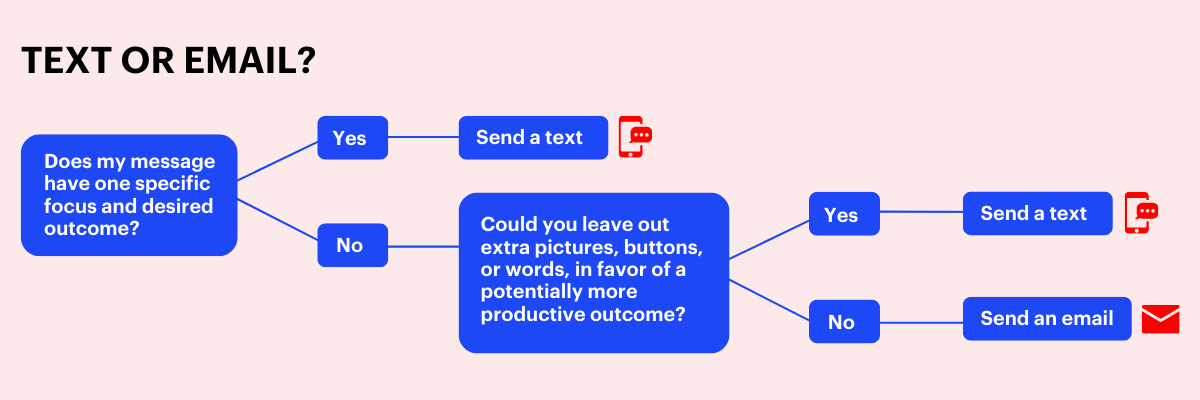Whether you’re just starting out or a business veteran, you’ve most likely encountered the familiar debate of how to market to your customers digitally. Historically, digital marketing strategies have leaned heavily into email and social media marketing, the latter growing ever more popular as Gen Z continues to influence trends and purchasing habits.
More recently, however, you might have noticed a dramatic spike in text marketing campaigns, as companies begin to shift from bulk email communications to personalized text conversations. The shift makes sense—mobile apps are generating organic traffic at such a high rate that brands want to stay top of mind where their customers hang out the most: on their phones.
But what makes text marketing so different from email marketing, and what are their key advantages in marketing to the modern customer? Let’s get into it.

Text Marketing: When should you use it?
In the big picture of digital marketing, text marketing is still a relatively new frontier that’s growing more refined, competitive, and popular by the year. And for good reasons. To state just a few, it requires a small fraction of the time and energy required to build and design a marketing email, and it opens the door for convenient, one-to-one text communication between you and your customers.
→What’s even more compelling, however, are the stats. Text marketing boasts an impressive 98% open rate with 95% of texts read within just three minutes. Sending an email? It goes straight to their inbox, housed with an app (or two) on their desktop or mobile devices. Their phone might send a notification, if they happen to have them turned on for their email apps.
Now, sending a text? Goes straight to their native messaging app, which already has notifications enabled organically. Your business shows up right next to their conversation with their spouse or best friend, and suddenly, you’re top of mind whenever they’re looking to text people. You’re now a saved contact.
→The low-maintenance nature of the medium means you can also have a lot more impact with a lot less effort. With text marketing, the briefer, the better. Focus on your main marketing message (i.e. event announcement, new product launch, big sale), and include an action for your customers to take once you’ve inevitably piqued their interest (i.e. click on a link to your website, respond to RSVP, etc.).
And just because it’s not in an email doesn’t mean you can’t still leverage high-quality images to showcase your products or services. Attach a gif, video, or photograph to give people a sneak peek into what value they could get after doing business with you. Just keep in mind that it’s best to keep it to one media per message—even the lift for media curation is low-maintenance.
→Not to mention it’s also clutter-free, meaning you’re much more likely to break through the noise of personal emails, newsletters, and other companies pushing their marketing content. (Anyone else struggling to get their email inbox to zero? You’re not alone).
The overall value of text marketing comes from its effectiveness and efficiency in launching campaigns quickly and reaping high-engagement results. Even if you have an established email marketing strategy in place already, it’s worth investing in learning more about how text marketing can elevate your current numbers and cut your time/energy efforts dramatically—if you prefer, start sending marketing texts as a complement to your emails and combine the power of both into an omni-channel marketing machine.

Email Marketing: When should you use it?
Email marketing is the original digi-marketing innovation that originated long before social media’s reign and the aforementioned texting novelty. The web-based letters have stood the test of time, primarily because they offer specific advantages that the other two major players can’t: long-form storytelling and multiple calls-to-action (i.e. buttons or links to click).
→Email’s long-form storytelling enables several media attachments, strategic placement of written content, and different calls-to-action—all in one email. Most likely, if you’re considering or implementing email marketing, it’s (hopefully) because you have a plethora of content to share with your customers.
From product photography to videos, your brand might express itself more visually through photoshoots, animations, and other rich media. And that’s great—visual assets are indeed a critical component of any marketing campaign. Both social media and text messaging also allow for the sending and sharing of rich media, but in different yet significant ways from email. Social media prioritizes visuals very highly (one might argue, even more so than its written content) while text messaging prioritizes the written content with a media attachment just complementing a single desired action (i.e. Link clicks, responses). Emails will provide your business with a bigger blank canvas to design on, perfect for when your aim is to entice with fresh, original visuals that will convert email opens into website clicks.
→If you need to give your customers multiple actions to take in one campaign, email might be better suited for you. Typically, it’s best practice to not overwhelm end consumers with too much of anything, whether that be visuals, words, or links. However, sometimes your business goals may require, or even benefit from, the risk of a little content overload. For instance, if you’re counting down the days to the launch of a major product collection, you want to showcase the various products being launched and provide pre-order links for each item. That way you can keep your audience broad and send confidently knowing you’ll reach people who are interested in each new product.
→But before you start emailing, consider the customer journey. Are you excited to share images of that new product collection that are already present on the website and your social media? Will your customers see similar content across your other channels? Does the information already exist on your site? If the answer to any of those questions is yes, then it might be time to reevaluate your main business goal in sending those emails. Keep in mind, the goal is rarely to impress customers with your beautifully crafted email but rather to be so inspired by your content that they click right through to your site. Consider bringing that inspiration into higher impact channels like social media or texting, where open rates and click rates consistently outperform email averages.
Before You Choose, Ask Yourself This
In the great digital debate of text versus email marketing, it really all comes down to the substance of your marketing message. Ask yourself: Does my message have one specific focus and desired outcome?
→If the answer is yes, your best bet is text marketing. It’s the more concise, more effective way to get your message read—it’s also the most efficient. Instead of obsessing over every pixel of your email, you can take less than 5 minutes to compose and launch a text. And if you have a single desired outcome, especially link clicks or customer responses, texts are the more practical medium to reach people instantly.
→If the answer is no, try again. No, really. Consider what your main message might be without a few pictures or extra buttons, in favor of more productive outcomes. If the answer is still no, then email marketing is definitely suited for your long-form marketing messages. Try spreading out your content in the email body to make it more digestible to the reading eye. Include high-quality images and a main call-to-action that the customer can take after you’ve just piqued their interest.

Final Thoughts
All in all, both text and email marketing provide ample opportunities for customer engagement. Take stock of your marketing assets and main messages, and consider which one suits your strategy best. Most often, you’ll find that text marketing can fit a majority of your needs, even if it means learning a new medium and cutting your content into concise, pithy texts.
Email marketing is a great complementary strategy alongside text if your business provides products or services that require or are enhanced by particular visual aids. You can also always learn what your audience prefers by either asking them when they subscribe to your promotions (i.e. “Would you prefer to be emailed or texted about our sales?”) or tracking engagement metrics like click rate and open rate across both channels.
Regardless of your route, as long as you lead with consumer behavior and interests in mind, you’re bound to see better results and, of course, much happier, more engaged customers.


